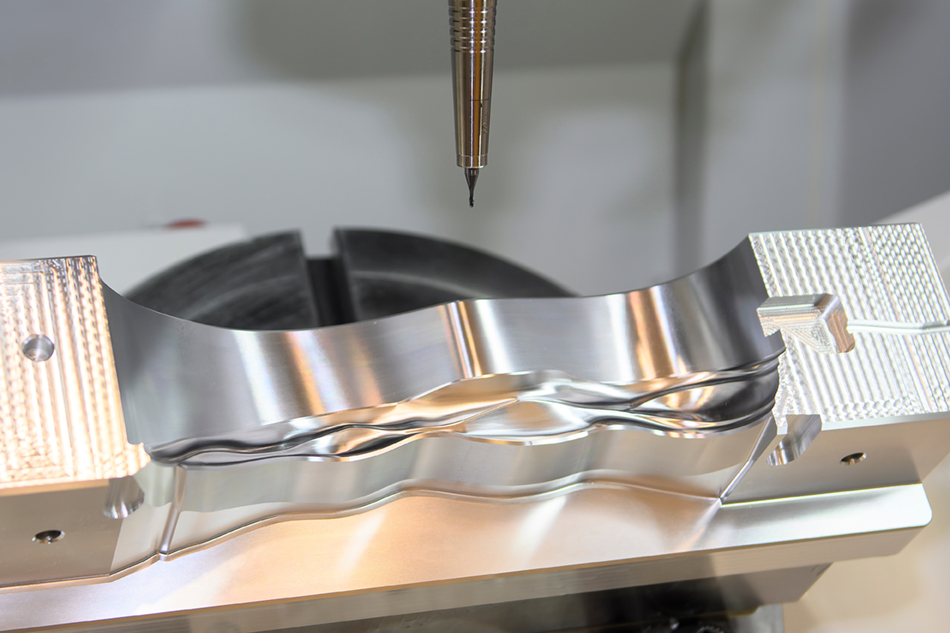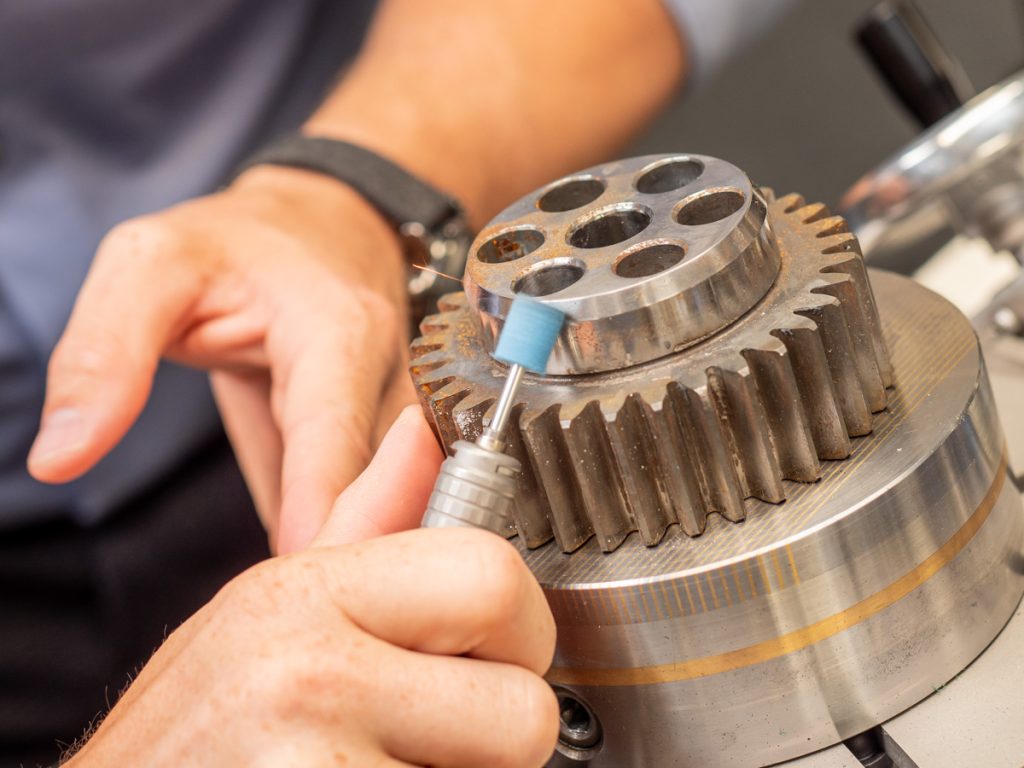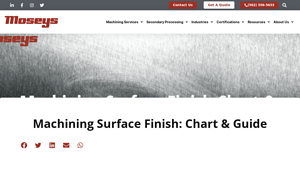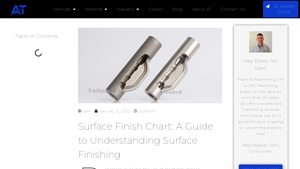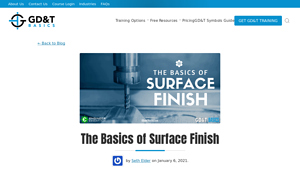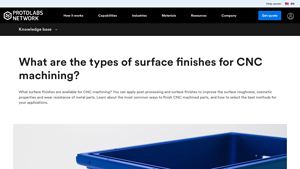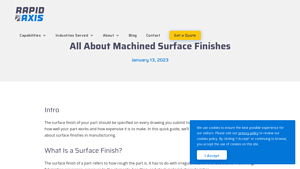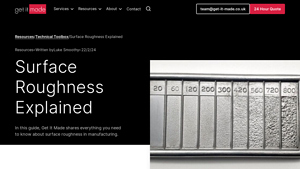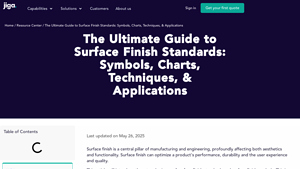Machine Finish Guide: Type, Cost, Top List…
Introduction: Navigating the Global Market for machine finish
In the competitive landscape of global manufacturing, sourcing the right machine finish is a pivotal challenge for international B2B buyers. A well-executed surface finish not only enhances the performance and durability of components but also ensures compliance with stringent industry standards. This comprehensive guide delves into the nuances of machine finish, offering insights into various types, applications across industries, and essential supplier vetting criteria. By understanding the intricacies of surface finish specifications and their impact on product quality, buyers from Africa, South America, the Middle East, and Europe—including countries like Vietnam and Saudi Arabia—can make informed purchasing decisions that align with their operational needs.
Navigating the complexities of sourcing machine finishes requires a strategic approach. This guide empowers buyers by breaking down key factors such as cost considerations, material compatibility, and the importance of quality certifications. Additionally, we explore the latest trends and technologies in surface finishing, equipping you with actionable insights to optimize your supply chain. Whether you are looking to enhance product aesthetics or improve functional performance, this resource serves as a roadmap for successfully navigating the global market for machine finishes, ensuring that you secure the best solutions for your manufacturing processes.
Understanding machine finish Types and Variations
| Type Name | Key Distinguishing Features | Primary B2B Applications | Brief Pros & Cons for Buyers |
|---|---|---|---|
| As Machined | Minor tool marks, roughness Ra of 3.2μm | General manufacturing, automotive | Pros: Cost-effective, quick turnaround. Cons: Limited surface protection and aesthetics. |
| Bead Blasting | Matte finish with a light texture | Aerospace, consumer products | Pros: Enhanced visual appeal, uniform surface. Cons: Limited durability compared to coatings. |
| Powder Coating | Durable, colorful finish with corrosion resistance | Industrial equipment, automotive | Pros: High impact resistance, customizable colors. Cons: Requires curing time, can be more expensive. |
| Anodizing Type II | Corrosion-resistant ceramic layer, dyeable | Aerospace, electronics | Pros: Excellent corrosion resistance, aesthetic options. Cons: Limited to aluminum and titanium. |
| Anodizing Type III | Stronger ceramic layer than Type II | Defense, high-performance components | Pros: Superior durability, excellent wear resistance. Cons: Higher cost, limited to specific materials. |
What Are the Key Characteristics of As Machined Finish?
The ‘As Machined’ finish is characterized by its minor tool marks and a standard surface roughness (Ra) of approximately 3.2μm. This finish is often suitable for applications that do not require stringent surface smoothness or aesthetic qualities. Buyers should consider that while it is a cost-effective option, it may not provide the necessary protection against corrosion or wear, which could impact the longevity and performance of components in demanding environments.
How Does Bead Blasting Enhance Surface Finish?
Bead blasting creates a matte finish with a subtle texture, making it particularly suitable for industries such as aerospace and consumer products where visual appeal is important. This process effectively enhances the uniformity of the surface while providing a degree of roughness that can aid in paint adhesion. Buyers should weigh the aesthetic benefits against the fact that bead blasting may not offer the same level of durability as other finishing methods, making it less ideal for high-wear applications.
What Advantages Does Powder Coating Offer to B2B Buyers?
Powder coating provides a durable and colorful finish that is particularly useful in industrial applications. This method offers high impact resistance and can be customized in various colors, making it appealing for manufacturers looking to enhance their product’s visual identity. However, buyers should note that powder coating requires a curing process, which can add to production time and costs, and may not be suitable for all metal types.
Why Choose Anodizing Type II for Your Components?
Anodizing Type II is recognized for adding a corrosion-resistant ceramic layer to aluminum or titanium parts, which can also be dyed in various colors. This finish is ideal for industries such as aerospace and electronics where both durability and aesthetics are critical. While it offers excellent protection against environmental factors, buyers should consider its limitations, as it is not applicable to all materials and may involve higher costs.
What Makes Anodizing Type III a Superior Choice?
Anodizing Type III, or hardcoat anodizing, provides an even stronger ceramic layer than Type II, making it suitable for high-performance components in sectors like defense and aerospace. This finish excels in wear resistance and durability, which are crucial for parts subjected to extreme conditions. However, the costs associated with this finishing method can be a consideration for buyers, especially when evaluating budget constraints against performance needs.
Key Industrial Applications of machine finish
| Industry/Sector | Specific Application of machine finish | Value/Benefit for the Business | Key Sourcing Considerations for this Application |
|---|---|---|---|
| Aerospace | Component manufacturing for aircraft engines | Enhanced performance and durability of critical engine parts | Compliance with stringent aerospace standards and certifications |
| Automotive | Engine and transmission components | Improved efficiency and reduced wear, leading to longer service life | Material quality and consistency, as well as surface finish specifications |
| Oil & Gas | Drilling equipment and valve manufacturing | Increased resistance to wear and corrosion in harsh environments | Supplier reliability and experience in high-stakes applications |
| Medical Devices | Surgical instruments and implants | High precision and smooth finishes ensure safety and functionality | Regulatory compliance (ISO, FDA) and traceability of materials |
| Electronics | Heat sinks and circuit board components | Enhanced thermal conductivity and reliability of electronic devices | Availability of advanced materials and adherence to tolerances |
How is Machine Finish Used in the Aerospace Industry?
In the aerospace sector, machine finish is crucial for the manufacturing of components such as aircraft engines and structural parts. The precision of surface finishes directly impacts the performance and reliability of these components, which must withstand extreme conditions. Buyers in this industry need to ensure that suppliers meet stringent aerospace standards and certifications, such as AS9100, to guarantee quality and safety.
What Role Does Machine Finish Play in the Automotive Sector?
Machine finish is vital in the automotive industry, particularly for engine and transmission components, where precision and durability are paramount. Smooth surface finishes reduce friction and wear, contributing to overall vehicle efficiency and longevity. International buyers should prioritize sourcing from suppliers that offer consistent quality and can meet specific surface roughness requirements to optimize performance.
How is Machine Finish Applied in the Oil & Gas Industry?
In the oil and gas sector, machine finish is essential for the manufacturing of drilling equipment and valves, which are exposed to harsh environments. A high-quality surface finish enhances resistance to wear and corrosion, thereby extending the lifespan of these critical components. Buyers must consider suppliers with proven reliability and experience in producing components that can withstand the extreme conditions typical of oil and gas operations.
Why is Machine Finish Important for Medical Devices?
For medical devices, machine finish is critical to ensure the safety and functionality of surgical instruments and implants. High precision and smooth finishes are necessary to minimize the risk of infection and ensure proper functionality in sensitive applications. Buyers in this field must ensure that their suppliers comply with regulatory standards such as ISO and FDA, emphasizing the need for traceability of materials and processes.
How Does Machine Finish Benefit the Electronics Industry?
In the electronics industry, machine finish plays a pivotal role in the production of heat sinks and circuit board components. A well-executed surface finish enhances thermal conductivity and the overall reliability of electronic devices. Buyers should focus on sourcing advanced materials that meet specific tolerances and performance requirements to ensure the longevity and efficiency of their products.
3 Common User Pain Points for ‘machine finish’ & Their Solutions
Scenario 1: Achieving Consistent Surface Quality Across Batches
The Problem: A manufacturing company in the automotive sector frequently faces issues with inconsistent surface finishes on machined components. This inconsistency leads to problems in assembly and performance, causing delays and increased costs. The buyer, responsible for sourcing these components, struggles to ensure that suppliers adhere to the required surface finish specifications, which vary based on the application. Such discrepancies can result in parts that do not fit properly, leading to increased wear and potential failure during use.
The Solution: To overcome this challenge, it is crucial for buyers to implement a robust supplier qualification process. Start by clearly defining the surface finish requirements in the technical specifications, including surface roughness parameters (Ra values) and any necessary treatments (e.g., anodizing or coating). Establishing a standard operating procedure (SOP) for quality checks can help ensure that suppliers meet these specifications consistently. Regular audits and reviews of supplier capabilities can also enhance quality control. Consider utilizing advanced measurement tools, like profilometers, to assess surface finish before parts are dispatched. This proactive approach will help mitigate the risks associated with inconsistent surface finishes and improve overall product reliability.
Scenario 2: Navigating Complex Surface Finish Standards
The Problem: A buyer for a medical device manufacturer encounters confusion regarding the various surface finish standards and specifications required for regulatory compliance. The challenge lies in interpreting the different surface finish symbols and requirements outlined in technical drawings, which can vary significantly between regions and regulatory bodies. This uncertainty risks non-compliance and potential delays in product launch, leading to financial losses and reputational damage.
The Solution: To effectively navigate this complexity, buyers should invest in training sessions focused on understanding surface finish standards, such as those provided by ASME or ISO. Collaborating with engineering teams and quality assurance personnel can foster a comprehensive understanding of surface finish requirements specific to the industry. Additionally, creating a centralized reference guide that outlines relevant standards, symbols, and measurement methods can serve as a valuable resource for both procurement and engineering teams. Engaging with suppliers who have a proven track record of compliance can further streamline the process. Ensuring that all stakeholders are aligned on surface finish requirements will facilitate smoother communication and compliance, reducing the risk of delays.
Scenario 3: Reducing Costs While Maintaining Surface Finish Quality
The Problem: A manufacturing company is under pressure to reduce production costs without compromising the quality of machined parts. The buyer notices that while cheaper raw materials can lower costs, they often lead to inferior surface finishes, which can affect the durability and performance of components. This creates a dilemma: how to source cost-effective materials while ensuring that surface finish requirements are still met.
The Solution: To strike a balance between cost and quality, buyers should consider implementing a value engineering approach. This involves analyzing the entire production process to identify opportunities for cost savings without compromising on quality. For instance, collaborating with suppliers to explore alternative materials that offer similar performance at lower costs can be beneficial. Additionally, investing in advanced machining technologies, such as CNC machines with better precision capabilities, can enhance surface finish quality and reduce the need for expensive post-processing treatments. Establishing long-term partnerships with reliable suppliers can also lead to negotiated bulk discounts, further reducing costs. By focusing on process efficiency and material optimization, buyers can achieve their financial goals while maintaining the required surface finish standards.
Strategic Material Selection Guide for machine finish
What Are the Key Properties of Common Materials Used in Machine Finishing?
When selecting materials for machine finishing, understanding the properties of each material is crucial for ensuring product performance. Here, we analyze four common materials: Aluminum, Stainless Steel, Cast Iron, and Titanium, focusing on their properties, advantages, disadvantages, and implications for international B2B buyers.
How Does Aluminum Perform in Machine Finishing Applications?
Aluminum is a lightweight metal known for its excellent corrosion resistance and good thermal conductivity. It can withstand moderate temperatures and pressures, making it suitable for various applications, including aerospace and automotive components.
Pros: Aluminum is relatively easy to machine, resulting in lower manufacturing complexity and costs. It is also highly recyclable, which is an attractive feature for environmentally conscious buyers.
Cons: While durable, aluminum can be less robust than other metals, particularly under high-stress conditions. Its susceptibility to scratching and denting may limit its use in high-wear environments.
Impact on Application: Aluminum is compatible with various media, including water and oil, but may not be suitable for harsh chemicals without protective coatings.
Considerations for International Buyers: Compliance with standards such as ASTM and DIN is essential. Buyers from regions like Africa and the Middle East may prefer aluminum for its lightweight properties, especially in transportation applications.
What Are the Advantages and Disadvantages of Stainless Steel in Machine Finishing?
Stainless steel is renowned for its strength, corrosion resistance, and ability to withstand high temperatures and pressures. It is commonly used in industries such as food processing, pharmaceuticals, and oil and gas.
Pros: The durability of stainless steel makes it an excellent choice for applications requiring strength and resistance to wear. Its surface finish can be enhanced through polishing or passivation, improving both aesthetics and performance.
Cons: Stainless steel can be more expensive than other materials, and its machining process is often more complex, leading to higher manufacturing costs.
Impact on Application: Stainless steel is compatible with a wide range of media, including corrosive substances, making it ideal for applications in challenging environments.
Considerations for International Buyers: Buyers should be aware of specific grades (e.g., 304, 316) that meet local standards. In regions like Europe and South America, stainless steel is often the preferred choice for its reliability in various applications.
How Does Cast Iron Compare in Machine Finishing?
Cast iron is known for its excellent wear resistance and ability to dampen vibrations, making it suitable for heavy machinery and automotive applications.
Pros: Cast iron is durable and cost-effective, offering good machinability and surface finish capabilities. It can withstand high temperatures and pressures, making it ideal for engine blocks and other high-stress components.
Cons: The brittleness of cast iron can be a drawback, as it may crack under extreme conditions. Additionally, it is heavier than alternatives like aluminum, which may affect transportation and installation.
Impact on Application: Cast iron is compatible with various lubricants and coolants but may corrode if exposed to moisture without proper coatings.
Considerations for International Buyers: Compliance with ASTM and ISO standards is critical. Buyers from Africa and the Middle East may find cast iron advantageous for its cost-effectiveness in large-scale manufacturing.
What Makes Titanium a Unique Choice for Machine Finishing?
Titanium is a high-strength, lightweight metal with exceptional corrosion resistance, often used in aerospace, medical, and high-performance applications.
Pros: Titanium’s strength-to-weight ratio is unmatched, making it ideal for applications where weight savings are critical. It is also biocompatible, making it suitable for medical implants.
Cons: The high cost of titanium and its challenging machinability can lead to increased manufacturing complexity and expenses.
Impact on Application: Titanium is compatible with aggressive media, including seawater and acidic environments, making it an excellent choice for marine and chemical applications.
Considerations for International Buyers: Buyers should consider compliance with international standards like ASTM and JIS. In regions like Europe and South America, the demand for titanium is growing, particularly in industries focused on innovation and high performance.
Summary Table of Material Selection for Machine Finishing
| Material | Typical Use Case for machine finish | Key Advantage | Key Disadvantage/Limitation | Relative Cost (Low/Med/High) |
|---|---|---|---|---|
| Aluminum | Aerospace, automotive components | Lightweight, good corrosion resistance | Less durable under high stress | Medium |
| Stainless Steel | Food processing, pharmaceuticals | High strength, corrosion resistant | Higher cost and manufacturing complexity | High |
| Cast Iron | Heavy machinery, engine blocks | Durable, cost-effective | Brittle, heavy | Low |
| Titanium | Aerospace, medical implants | Exceptional strength-to-weight ratio | High cost, challenging to machine | High |
This analysis provides a comprehensive overview of material properties and considerations for international B2B buyers, aiding in informed decision-making for machine finishing applications.
In-depth Look: Manufacturing Processes and Quality Assurance for machine finish
What Are the Key Manufacturing Processes for Achieving Machine Finish?
Achieving a precise machine finish involves several critical stages in the manufacturing process. Each stage plays a vital role in ensuring that the final product meets the required specifications and performance standards.
How Is Material Prepared for Machining?
Material preparation is the foundation of effective machining. It begins with selecting the appropriate raw materials based on the desired properties of the final product. Common materials include various metals such as stainless steel, aluminum, and titanium.
Once selected, the materials undergo processes such as cutting, shearing, or sawing to achieve rough shapes. This is followed by cleaning to remove any contaminants, which can affect the machining quality. Effective material preparation ensures that the subsequent machining processes yield optimal results.
What Forming Techniques Are Utilized in Machine Finishing?
Forming techniques vary widely depending on the complexity and requirements of the final product. Key methods include:
-
CNC Machining: Computer Numerical Control (CNC) machines enable precise shaping and finishing of parts. CNC milling and turning are prevalent for achieving complex geometries with tight tolerances.
-
Casting and Forging: For larger components, casting and forging techniques are employed to shape the material before finer machining processes occur. These methods can enhance the structural integrity of the final product.
-
Laser Cutting: This technique offers high precision for intricate designs, minimizing material waste and allowing for rapid prototyping.
Each of these forming techniques contributes to the overall surface finish, impacting the subsequent finishing processes.
How Are Parts Assembled and Finished for Quality Control?
Assembly is a critical stage where individual components are brought together to form the final product. This may involve welding, bolting, or using adhesives, depending on the design specifications. Proper alignment and fit are essential to ensure that the assembled product meets performance criteria.
The finishing processes are where the machine finish is truly defined. Techniques include:
-
Grinding: This process removes material to achieve a specified surface roughness. It is essential for parts that require tight tolerances.
-
Polishing: Polishing enhances the aesthetic appeal and can improve corrosion resistance. It is often used in industries such as aerospace and medical devices.
-
Coating: Applications such as anodizing, powder coating, or plating are employed to enhance durability and resistance to environmental factors. These coatings can also provide additional functionality, such as electrical conductivity or thermal resistance.
What Are the International Quality Control Standards for Machine Finish?
Quality control (QC) is paramount in manufacturing, particularly for machine finishes that must meet stringent specifications. Understanding the relevant international standards is crucial for B2B buyers to ensure that their suppliers adhere to the necessary quality benchmarks.
Which International Standards Should B2B Buyers Be Aware Of?
Key standards include:
-
ISO 9001: This standard focuses on quality management systems, ensuring that organizations consistently meet customer and regulatory requirements. It emphasizes continuous improvement, which is vital for maintaining high-quality machining processes.
-
ISO 13485: For manufacturers in the medical device sector, this standard specifies requirements for a quality management system that demonstrates the ability to provide medical devices and related services.
-
AS9100: This standard is essential for the aerospace industry, focusing on quality management systems and ensuring safety and reliability in aerospace manufacturing.
-
API Standards: For buyers in the oil and gas sector, the American Petroleum Institute (API) standards outline quality requirements specific to this industry.
What Are the Key QC Checkpoints in the Manufacturing Process?
Quality control checkpoints are essential for maintaining product integrity throughout the manufacturing process. Key checkpoints include:
-
Incoming Quality Control (IQC): This stage involves inspecting raw materials before they enter the production process. Ensuring that materials meet specified standards prevents defects from occurring downstream.
-
In-Process Quality Control (IPQC): During manufacturing, ongoing inspections are conducted to monitor processes and address any deviations from specifications immediately.
-
Final Quality Control (FQC): After assembly, the final product undergoes thorough inspections to ensure it meets all quality standards before shipment.
What Testing Methods Are Commonly Used in Machine Finishing?
Testing methods vary based on the industry and product requirements, but some common methods include:
-
Surface Roughness Measurement: Tools such as profilometers are used to assess the surface roughness, providing quantitative data that helps ensure compliance with specifications.
-
Dimensional Inspection: Techniques such as coordinate measuring machines (CMM) are employed to verify that dimensions are within tolerances.
-
Non-Destructive Testing (NDT): Methods like ultrasonic testing and dye penetrant testing assess the integrity of materials without causing damage.
How Can B2B Buyers Verify Supplier Quality Control Practices?
For international B2B buyers, especially those from diverse regions like Africa, South America, the Middle East, and Europe, verifying a supplier’s quality control practices is crucial. Here are actionable steps:
-
Conduct Audits: Regular audits of suppliers can provide insight into their quality control processes. This includes reviewing their adherence to international standards and internal QC protocols.
-
Request Quality Reports: Suppliers should provide documentation, such as inspection reports and certificates of compliance, detailing the results of their quality checks.
-
Third-Party Inspections: Engaging independent third-party inspectors can offer an unbiased assessment of a supplier’s quality management practices, ensuring that products meet the necessary standards before shipment.
What Are the Nuances of QC and Certification for International Buyers?
Navigating the complexities of quality control and certification is particularly important for international B2B buyers. Understanding the nuances of certification requirements across different regions can prevent costly compliance issues.
Buyers should be aware of regional certifications that may be required, such as CE marking for products sold in Europe or API certifications for oil and gas products. Familiarizing oneself with these requirements can facilitate smoother transactions and build trust with suppliers.
By understanding the manufacturing processes and quality assurance measures associated with machine finishes, B2B buyers can make informed decisions, ensuring they partner with suppliers who maintain the highest quality standards.
Practical Sourcing Guide: A Step-by-Step Checklist for ‘machine finish’
When sourcing machine finishes for your B2B operations, it’s essential to have a structured approach. This checklist serves as a practical guide to help international buyers effectively navigate the procurement process for machine finish services. By following these steps, you can ensure quality and compatibility with your project requirements.
Step 1: Define Your Technical Specifications
Before reaching out to suppliers, clearly outline your technical requirements. This includes the type of material, desired surface finish, tolerances, and any industry-specific standards. Having precise specifications helps in communicating your needs effectively and ensures that suppliers can meet your expectations.
- Consider the application: Different industries have varying requirements for surface finishes. For example, aerospace components may require stricter tolerances than those used in general manufacturing.
- Specify roughness parameters: Understand the roughness parameters (like Ra or Rz) required for your parts to facilitate better performance and longevity.
Step 2: Research Potential Suppliers
Once your specifications are ready, start researching suppliers who specialize in machine finishes. Look for companies with a proven track record in your industry and those that can handle your specific material needs.
- Check their portfolio: Evaluate their previous work and case studies to gauge their capabilities.
- Seek customer reviews: Look for feedback from other businesses to assess reliability and quality.
Step 3: Verify Supplier Certifications
Certifications can be an indicator of a supplier’s commitment to quality and standards. Ensure that your potential suppliers hold relevant certifications such as ISO 9001 or industry-specific accreditations.
- Request documentation: Ask for copies of their certifications and ensure they are up to date.
- Understand their quality control processes: Inquire about their quality assurance methods to ensure they align with your requirements.
Step 4: Request Samples or Prototypes
Before making a large commitment, request samples or prototypes of your required finishes. This allows you to evaluate the quality and consistency of their work firsthand.
- Assess the finish quality: Check for smoothness, uniformity, and adherence to your specifications.
- Conduct performance testing: If applicable, test the samples under real-world conditions to ensure they meet your application needs.
Step 5: Discuss Lead Times and Capacity
Understanding the supplier’s production capacity and lead times is crucial for project planning. Engage in discussions about their typical turnaround times and how they manage peak production periods.
- Evaluate flexibility: Determine if they can accommodate changes in order size or rush requests.
- Assess their logistics capabilities: Ensure they can deliver to your location efficiently, especially if you are sourcing internationally.
Step 6: Negotiate Pricing and Terms
Once you’ve narrowed down your options, engage in negotiations regarding pricing and payment terms. Ensure you understand what is included in the pricing, such as tooling costs or shipping fees.
- Consider total cost of ownership: Look beyond the initial price to consider factors like quality, reliability, and potential rework costs.
- Clarify payment terms: Establish clear payment milestones to protect your investment.
Step 7: Establish Communication Channels
Finally, set up effective communication channels with your chosen supplier. Clear communication is key to resolving issues quickly and ensuring project alignment.
- Designate points of contact: Identify who will manage the relationship on both sides.
- Schedule regular updates: Agree on a schedule for progress updates to keep both parties informed.
By following this step-by-step checklist, you can streamline your sourcing process for machine finishes, ensuring that you select the right supplier that meets your quality and operational needs.
Comprehensive Cost and Pricing Analysis for machine finish Sourcing
What Are the Key Cost Components in Machine Finish Sourcing?
When sourcing machine finishes, understanding the cost structure is essential for international B2B buyers. The primary cost components involved include:
-
Materials: The type of materials used significantly affects the cost. Common materials for machine finishes include aluminum, stainless steel, and various alloys. Prices fluctuate based on market demand and regional availability, making it vital to stay updated on material costs.
-
Labor: Labor costs vary by region and skill level required for the finishing process. Highly skilled workers, especially in regions with a shortage of skilled labor, can drive costs up. For buyers, understanding local labor rates can help in budgeting accurately.
-
Manufacturing Overhead: This includes costs associated with running machinery, utilities, and facility maintenance. Overhead costs can vary widely depending on the supplier’s operational efficiency and location.
-
Tooling: Custom tooling may be necessary for specific finishes, impacting initial setup costs. Buyers should inquire about tooling fees, particularly for low-volume orders, which can be disproportionately high.
-
Quality Control (QC): Rigorous quality assurance processes are essential, particularly for industries like aerospace and medical, where safety and reliability are paramount. The costs associated with QC can vary based on the complexity of the finish and the certification standards required.
-
Logistics: Shipping and handling costs must be factored into total pricing, especially for international transactions. The choice of Incoterms can significantly influence logistics costs and responsibilities.
-
Margin: Suppliers will add a profit margin to their costs, which can vary based on competition, market conditions, and the perceived value of the service offered.
How Do Price Influencers Impact Machine Finish Costs?
Several factors can influence the pricing of machine finishes:
-
Volume/MOQ: Minimum order quantities (MOQ) can affect pricing. Higher volumes often lead to reduced per-unit costs due to economies of scale. Conversely, low-volume orders may incur higher costs due to setup fees.
-
Specifications and Customization: Custom finishes or unique specifications can significantly increase costs. Buyers should clearly define their requirements to avoid unexpected expenses.
-
Materials: The choice of material not only impacts the base cost but also the finishing process and associated labor. Specialty materials may require more advanced techniques, further increasing costs.
-
Quality and Certifications: Products requiring specific certifications (like ISO or NADCAP) often have higher costs due to the added compliance and testing requirements. Buyers should factor in these potential costs when selecting suppliers.
-
Supplier Factors: The supplier’s reputation, experience, and location can all influence pricing. Established suppliers with proven track records may charge premium prices, but they often provide higher reliability and quality assurance.
-
Incoterms: Understanding Incoterms is crucial for international buyers, as they define the responsibilities of buyers and sellers concerning shipping, insurance, and tariffs. This can directly affect the total cost of ownership.
What Are the Best Tips for Negotiating Machine Finish Prices?
-
Conduct Thorough Market Research: Familiarize yourself with average market prices for the specific finishes you require. This knowledge can empower you during negotiations.
-
Emphasize Long-Term Relationships: Suppliers are often willing to negotiate better terms for buyers who commit to long-term relationships, which can lead to better pricing and service.
-
Evaluate Total Cost of Ownership (TCO): Consider not just the upfront costs but also long-term implications, such as durability, maintenance, and potential rework costs. A cheaper finish might lead to higher costs over time due to wear and tear.
-
Be Clear About Specifications: Clearly define your requirements to avoid misunderstandings that could lead to higher costs. Providing detailed drawings and specifications can help suppliers give more accurate quotes.
-
Explore Multiple Suppliers: Don’t hesitate to obtain quotes from various suppliers. This approach not only provides leverage in negotiations but also helps identify the best value for your needs.
Conclusion
While the costs associated with machine finishes can vary widely based on numerous factors, informed decision-making can lead to significant savings. By understanding the cost components and price influencers, B2B buyers from regions like Africa, South America, the Middle East, and Europe can strategically navigate the sourcing landscape. Keep in mind that prices can fluctuate, so maintaining an agile approach to sourcing is advisable.
Alternatives Analysis: Comparing machine finish With Other Solutions
Exploring Alternatives to Machine Finish in Manufacturing
In the realm of manufacturing, achieving optimal surface quality is crucial for the performance and longevity of components. While machine finishing remains a widely adopted method, several alternative solutions can also provide effective results. This section explores these alternatives, facilitating informed decision-making for B2B buyers across diverse industries and regions.
Comparison Table
| Comparison Aspect | Machine Finish | Bead Blasting | Powder Coating |
|---|---|---|---|
| Performance | High durability; smooth surface reduces wear. | Enhances aesthetics; not as durable as machine finish. | Provides excellent wear and corrosion resistance. |
| Cost | Moderate to high; depends on complexity. | Generally lower; cost-effective for larger batches. | Higher initial investment but long-term cost savings. |
| Ease of Implementation | Requires skilled labor and specialized machinery. | Easier to implement; less technical skill needed. | Requires specialized equipment and training. |
| Maintenance | Low; durable finishes require minimal upkeep. | Moderate; surfaces can degrade over time. | Low; long-lasting finish but may need occasional touch-ups. |
| Best Use Case | Precision parts in aerospace, automotive, and medical fields. | Decorative applications or where a non-slip surface is desired. | High-wear components in automotive, industrial, and consumer products. |
In-Depth Look at Alternatives
Bead Blasting
Bead blasting is a surface treatment method that involves bombarding the surface with small beads, resulting in a matte finish. This technique is particularly beneficial for aesthetic applications where a non-reflective surface is desired. It effectively removes imperfections, but its durability does not match that of machine finishing. Bead blasting is generally less expensive and easier to implement, making it suitable for projects where cost is a critical factor, but it may not be ideal for precision components requiring high durability.
Powder Coating
Powder coating is an advanced finishing process where a dry powder is applied electrostatically and then cured under heat. This method yields a thick, uniform, and durable finish that is highly resistant to wear, corrosion, and impacts. While it requires a higher initial investment and specialized equipment, the long-term benefits, such as reduced maintenance and enhanced product life, can justify the cost. Powder coating is best suited for high-wear applications, but it may not provide the precision surface finishes required in critical engineering contexts.
Conclusion: Choosing the Right Surface Finishing Solution
For B2B buyers, the choice between machine finish and its alternatives hinges on specific project requirements. Factors such as performance needs, budget constraints, and the complexity of implementation play a pivotal role. Machine finishing is ideal for precision components demanding high durability, while bead blasting offers an economical solution for decorative purposes. Powder coating stands out for its exceptional protective qualities, making it suitable for demanding environments. By thoroughly assessing these aspects, buyers can select the most appropriate finishing method to meet their operational goals.
Essential Technical Properties and Trade Terminology for machine finish
What Are the Key Technical Properties of Machine Finish?
Understanding the essential technical properties associated with machine finishes is crucial for B2B buyers, especially when sourcing components for diverse applications. Here are some critical specifications to consider:
1. Surface Roughness (Ra)
Surface roughness, commonly represented as Ra, quantifies the texture of a surface by measuring the average deviation of the surface profile from the mean line. A lower Ra value indicates a smoother surface, which is vital for parts requiring tight tolerances and minimal friction. In B2B scenarios, specifying the appropriate Ra can significantly enhance product performance, particularly in industries like aerospace and automotive where precision is paramount.
2. Tolerance Levels
Tolerance defines the permissible limit or limits of variation in a physical dimension. It is crucial for ensuring that parts fit together correctly and function as intended. In B2B transactions, communicating the required tolerance levels can prevent costly rework or rejection of components, thus improving supply chain efficiency and maintaining production schedules.
3. Material Grade
The material grade specifies the type and quality of material used in the manufacturing process, which directly affects the durability and performance of the final product. For instance, using high-grade stainless steel for a component that requires corrosion resistance can enhance its lifespan. Buyers must be aware of material grades to ensure compatibility with their specific applications, especially in sectors like oil and gas or medical devices.
4. Coating and Finishing Options
Coatings and surface treatments, such as anodizing or powder coating, enhance the physical properties of a product by providing additional protection against wear, corrosion, and other environmental factors. Understanding the available options and their benefits is essential for B2B buyers who aim to meet specific performance criteria while optimizing costs.
5. Machining Process Type
Different machining processes, such as CNC machining, milling, or turning, yield distinct surface finishes and characteristics. Knowing the advantages and limitations of each process allows buyers to select the most appropriate method for their needs. This knowledge can lead to better product outcomes and cost savings by aligning manufacturing capabilities with project requirements.
What Are Common Trade Terms Related to Machine Finish?
Familiarity with industry jargon can facilitate smoother communication and negotiations in B2B contexts. Here are some commonly used terms:
1. OEM (Original Equipment Manufacturer)
An OEM is a company that produces parts or equipment that may be marketed by another manufacturer. Understanding OEM relationships is critical for B2B buyers, as it often dictates the quality and compatibility of components within larger systems.
2. MOQ (Minimum Order Quantity)
MOQ refers to the smallest quantity of a product that a supplier is willing to sell. This term is particularly important for buyers looking to manage inventory costs effectively. Knowing the MOQ helps in budgeting and planning for production runs.
3. RFQ (Request for Quotation)
An RFQ is a document sent to suppliers asking for a quote on specific products or services. It typically includes detailed specifications, quantities, and delivery requirements. For B2B buyers, an RFQ is a critical tool for comparing pricing and capabilities among different suppliers.
4. Incoterms (International Commercial Terms)
Incoterms are a set of predefined commercial terms published by the International Chamber of Commerce (ICC) that clarify the responsibilities of buyers and sellers in international transactions. Familiarity with Incoterms helps buyers understand shipping costs, risks, and logistics, ensuring smoother cross-border transactions.
5. Lead Time
Lead time is the time taken from placing an order to the delivery of the product. Understanding lead times is vital for B2B buyers to ensure that production schedules align with supply chain timelines, thus minimizing delays and optimizing workflow.
In conclusion, a solid grasp of the technical properties and trade terminology related to machine finish equips B2B buyers with the knowledge needed to make informed purchasing decisions, ultimately enhancing operational efficiency and product quality.
Navigating Market Dynamics and Sourcing Trends in the machine finish Sector
What Are the Current Market Dynamics and Key Trends in the Machine Finish Sector?
The machine finish sector is experiencing significant transformations driven by technological advancements, changing consumer demands, and global economic shifts. A key market driver is the increasing demand for precision-engineered components across diverse industries such as aerospace, automotive, and electronics. International B2B buyers, particularly from Africa, South America, the Middle East, and Europe, are increasingly seeking suppliers that can deliver high-quality machined parts with specific surface finish requirements to enhance product performance and durability.
Emerging technologies, such as automation and artificial intelligence, are reshaping sourcing strategies. Many manufacturers are adopting Industry 4.0 practices, which include smart manufacturing systems that optimize production efficiency and reduce lead times. Additionally, advanced machining techniques, like additive manufacturing and CNC machining, are gaining traction, offering greater flexibility and customization options for buyers.
Furthermore, the global sourcing landscape is evolving, with international buyers focusing on establishing long-term partnerships with suppliers who can provide reliable quality control and consistent delivery. Countries like Vietnam and Saudi Arabia are becoming attractive sourcing hubs due to their competitive labor costs and improving manufacturing capabilities. As a result, B2B buyers must stay informed about regional trends, regulatory changes, and shifts in supplier capabilities to make strategic sourcing decisions.
How Important Is Sustainability and Ethical Sourcing in the Machine Finish Sector?
Sustainability has become a crucial consideration for B2B buyers in the machine finish sector. The environmental impact of manufacturing processes, including waste generation and energy consumption, is under increasing scrutiny. Buyers are now prioritizing suppliers who demonstrate a commitment to sustainable practices, such as using energy-efficient machinery and minimizing waste through advanced machining techniques.
Ethical sourcing is also gaining prominence, with buyers seeking transparency in supply chains to ensure fair labor practices and responsible sourcing of materials. Certifications such as ISO 14001 for environmental management and ISO 45001 for occupational health and safety are becoming essential criteria for supplier selection. These certifications not only reflect a company’s commitment to sustainability but also help mitigate risks associated with non-compliance.
Moreover, the use of ‘green’ materials, such as recycled metals and eco-friendly coatings, is becoming increasingly important in meeting regulatory requirements and consumer preferences. Buyers who prioritize sustainability and ethical sourcing can enhance their brand reputation and attract environmentally-conscious customers, ultimately driving business growth in an increasingly competitive market.
What Has Been the Evolution of the Machine Finish Sector?
The machine finish sector has evolved significantly over the decades, transitioning from traditional hand-finishing techniques to highly automated and precision-oriented processes. In the early stages of manufacturing, surface finishing relied heavily on manual labor, which often resulted in inconsistent quality and longer production times.
With the advent of CNC machining in the late 20th century, manufacturers began to adopt more sophisticated technology, enabling precise control over machining processes and surface finishes. This shift not only improved product quality but also increased production efficiency, allowing companies to meet rising global demand.
In recent years, the focus has shifted toward advanced surface finishing techniques that enhance performance attributes, such as wear resistance and corrosion protection. As international B2B buyers continue to seek out innovative solutions, the machine finish sector is likely to witness further advancements, driven by the integration of new materials and technologies that cater to evolving market needs.
Frequently Asked Questions (FAQs) for B2B Buyers of machine finish
-
How do I solve issues related to surface finish quality in machined parts?
To address surface finish quality issues, start by identifying the specific requirements of your application. Collaborate closely with your supplier to establish clear specifications, including surface roughness, waviness, and lay direction. Utilize advanced measurement tools like profilometers to assess the current surface condition. If defects are present, explore post-processing options such as polishing or coating to enhance the finish. Consistent communication and quality checks throughout the production process can prevent future issues and ensure that the final product meets your standards. -
What is the best surface finish for aerospace components?
For aerospace components, a high-quality surface finish is critical due to the demanding operational environment. Typically, finishes such as anodizing or precision grinding are preferred, as they provide excellent wear resistance and corrosion protection. The Ra (average roughness) value should ideally be below 0.4μm to ensure optimal performance. Consult with your manufacturer to align on specific industry standards and testing protocols, such as AS9100, to ensure compliance with aerospace regulations. -
What factors should I consider when selecting a supplier for machined finishes?
When selecting a supplier, assess their experience and specialization in your industry, such as aerospace, automotive, or medical. Review their quality certifications, such as ISO 9001 or NADCAP, which indicate their commitment to quality management. Evaluate their production capabilities, including the technology and equipment they use for machining and finishing. Additionally, consider their logistical efficiency and ability to meet your deadlines, as well as their responsiveness to inquiries and willingness to provide customization options. -
What are the typical minimum order quantities (MOQs) for machined finishes?
Minimum order quantities for machined finishes can vary significantly depending on the supplier, the complexity of the part, and the materials used. Generally, MOQs can range from a few units for highly specialized items to hundreds or thousands for standard components. When negotiating with suppliers, clarify your requirements and express your needs for flexibility, especially for pilot runs or prototypes. Establishing a long-term partnership can also lead to more favorable MOQ terms. -
How can I ensure quality assurance for my machined parts?
To ensure quality assurance, request detailed quality control documentation from your supplier, including inspection reports and certifications. Implement a robust incoming inspection process to verify that parts meet your specifications upon delivery. Consider establishing quality metrics, such as defect rates and compliance with surface finish standards, to monitor supplier performance. Regular audits and site visits can also foster transparency and strengthen the quality assurance process. -
What payment terms are commonly used in international B2B transactions for machined finishes?
Payment terms in international B2B transactions typically include options such as upfront deposits, letters of credit, or net payment terms (e.g., net 30 or net 60). It’s essential to negotiate terms that balance cash flow with risk management. Ensure that both parties are clear on payment schedules and conditions for final payment, especially for large orders. Consider leveraging escrow services for additional security, particularly when dealing with new suppliers. -
What logistics considerations should I keep in mind when importing machined parts?
Logistics considerations include understanding shipping methods, customs regulations, and potential tariffs associated with importing machined parts. Choose reliable logistics partners who can navigate international shipping complexities and provide tracking services. Ensure that your supplier is familiar with export documentation requirements and can assist in preparing necessary paperwork. Additionally, consider the lead time for production and shipping to avoid delays that could impact your supply chain. -
How do surface finishes impact the performance and longevity of machined components?
Surface finishes significantly influence the performance and longevity of machined components. A smoother finish reduces friction, which minimizes wear and tear, enhancing durability. Proper surface treatments, such as anodizing or coating, can also provide corrosion resistance, extending the lifespan of parts exposed to harsh environments. Additionally, achieving the right surface texture can improve the adhesion of paints or coatings, ensuring that components maintain their aesthetic and functional qualities over time.
Important Disclaimer & Terms of Use
⚠️ Important Disclaimer
The information provided in this guide, including content regarding manufacturers, technical specifications, and market analysis, is for informational and educational purposes only. It does not constitute professional procurement advice, financial advice, or legal advice.
While we have made every effort to ensure the accuracy and timeliness of the information, we are not responsible for any errors, omissions, or outdated information. Market conditions, company details, and technical standards are subject to change.
B2B buyers must conduct their own independent and thorough due diligence before making any purchasing decisions. This includes contacting suppliers directly, verifying certifications, requesting samples, and seeking professional consultation. The risk of relying on any information in this guide is borne solely by the reader.
Top 8 Machine Finish Manufacturers & Suppliers List
1. Moseys – Machining Surface Finish Chart & Specifications
Domain: moseys.com
Registered: 2000 (25 years)
Introduction: Machining Surface Finish Chart & Specifications – Moseys Production Machinists
**Machining Services:** Continuous 24/7 production machining, parts ranging from 0.050″ to 24″, quality guaranteed.
**Material Specialties:** Cast Iron, Cast Aluminium, Aluminum, Stainless Steel, Steel, Bronze, Plastic, Titanium, Inconel Alloy.
**Secondary Processing:** End-to-End Parts Supply including full service …
2. At Machining – Surface Finish Guide
Domain: at-machining.com
Registered: 2014 (11 years)
Introduction: Surface Finish Chart: A guide to understanding surface finishing processes. Key characteristics of surface finish include surface roughness, waviness, and lay. Surface finish affects product durability, performance, lubrication, friction, and corrosion resistance. Measurement methods include contact methods (stylus probe), non-contact methods (optical, laser, X-ray), and comparison methods. AT-Mac…
3. GD&T Basics – Surface Finish Standards
Domain: gdandtbasics.com
Registered: 2014 (11 years)
Introduction: Surface finish refers to the texture of a surface, often specified in technical drawings for mechanical parts. It consists of three elements: roughness, lay, and waviness. The American Society of Mechanical Engineers (ASME) has published standards for surface texture symbols (Y14.36M) and definitions/measurement methods (B41.6). Roughness is the most commonly specified aspect, measured using a pro…
4. Hubs – Surface Finishes for CNC Machining
Domain: hubs.com
Registered: 1998 (27 years)
Introduction: Types of surface finishes for CNC machining include: 1. As Machined: Standard surface roughness (Ra) of 3.2 μm, visible tool marks. 2. Bead Blasting: Matte finish with light texture, improves visual appearance. 3. Anodizing Type II: Adds a corrosion-resistant ceramic layer, available for aluminum and titanium, can be dyed. 4. Anodizing Type III: Hardcoat, offers greater protection than Type II, al…
5. Rapid Axis – Advanced Machining and Fabrication Solutions
Domain: rapidaxis.com
Registered: 2018 (7 years)
Introduction: Rapid Axis offers a variety of machining capabilities including CNC Machining, CNC Milling, CNC Turning, 2nd Op Machining, Sheet Metal Fabrication, Laser Cutting, Waterjet Cutting, and 3D Printing (FDM, MJF, SLS, SLA, Polyjet). They provide tooling and molding services, urethane casting, production and prototype die casting, injection molding, prototype injection molding, stamping, and die cutting…
6. Get It Made – Manufacturing Services
Domain: get-it-made.co.uk
Registered: 2014 (11 years)
Introduction: Get It Made offers a range of manufacturing services including: CNC Machining Service (5 axis CNC machining, CNC turning, CNC milling), 3D Printing Service (personalized solutions with diverse materials and color options), Subtractive CNC, Metal Forming, Custom Aluminium Extrusion, Custom Sheet Metal Fabrication, Assembly & Welding, Moulding & Casting (Plastic Injection Moulding, Aluminium Die Cas…
7. Jiga – Surface Finish Solutions
Domain: jiga.io
Registered: 2020 (5 years)
Introduction: Surface finish is a central pillar of manufacturing and engineering, affecting aesthetics and functionality. Key properties include roughness, waviness, and lay. Functional importance includes friction reduction, wear resistance, and sealing performance. Aesthetic considerations influence consumer perception and brand identity. Effective surface finishes optimize performance, material compatibilit…
8. Makerverse – As-Machined Finish Solutions
Domain: makerverse.com
Registered: 2012 (13 years)
Introduction: As-Machined Finish: A surface condition of a part straight from CNC machining with no additional polishing or post-processing. Ideal for fast-turnaround prototyping, cost-sensitive parts, non-visible components, and applications where surface roughness is not critical. Good for functional prototypes, bonding and coating applications, and lower manufacturing costs. Avoid for high friction or tight …
Strategic Sourcing Conclusion and Outlook for machine finish
In the realm of machine finish, strategic sourcing emerges as a critical component for international B2B buyers seeking to enhance product quality and operational efficiency. Understanding the nuances of surface finishes—such as roughness, lay, and waviness—enables companies to select the right finishing processes that align with their specific industry requirements. By leveraging comprehensive supplier management and quality control, businesses can ensure that their machined parts not only meet rigorous standards but also contribute to the longevity and performance of their products.
For buyers in Africa, South America, the Middle East, and Europe, fostering strong relationships with reliable suppliers is paramount. This collaboration can lead to innovative solutions, improved cost-effectiveness, and enhanced competitiveness in an increasingly globalized market. As you navigate the complexities of sourcing, prioritize suppliers who demonstrate a commitment to quality and timely delivery.
Looking ahead, the demand for precision machined components will continue to rise, driven by advancements in technology and evolving market needs. Equip your business for success by embracing strategic sourcing practices that prioritize quality and performance. Connect with leading manufacturers today to ensure your products stand out in the marketplace.
